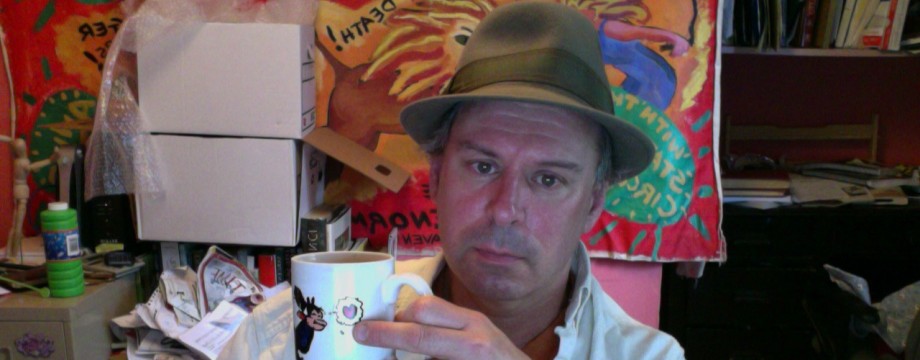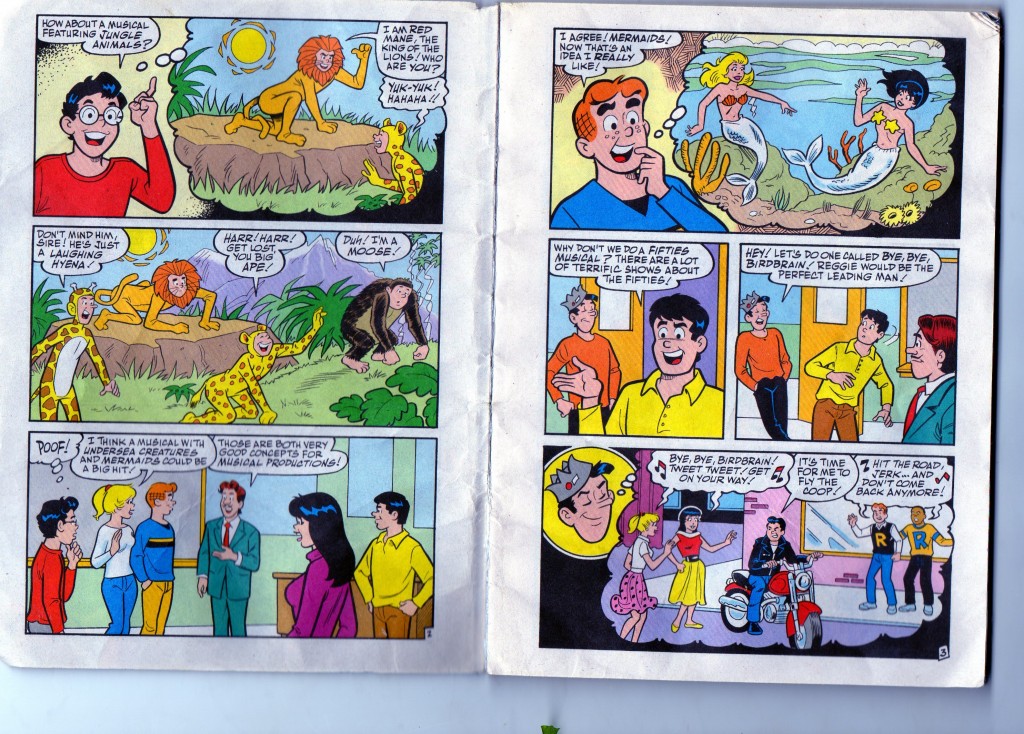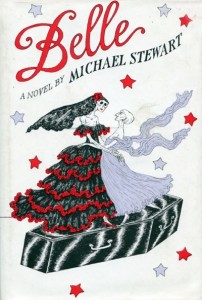Archie and the gang end up writing a ’50s-themed show, Riverdale Rocks (working title: Riverdale Greasers), but I’d much rather see more of these Disney adaptations.From Archie Digest #253, June 2009.
Three Books (like, novels) by Guys Who Wrote Books (like, for musicals)
It’d be unfair to suggest that Jerome Weidman was more of a musical-book writer than a more conventional book writer—I Can Get It for You Wholesale was a well-received novel before it inspired a musical. And it would be unfair to call a novel by Noel Coward an anomaly—he wrote several. But Weidman and Coward are best known as men of the theater. They, and Michael Stewart (whose books for Bye Bye Birdie, George M! and Mack & Mabel eclipse any writings he did in other formats) are men of the theater. They can’t write novels without betraying that.
Two of these book are directly about the theater. The other, Belle, is an unusual slow-paced suspense thriller about a 90-year-old society woman whose friends are dying off almost on a timetable while she lives on and on). They’re all mostly about the act of writing and the art of being famous.
Word of Mouth by Jerome Weidman (Random House, 1964)
“It is all settled,” Mr. Zucker announced at the other end of the wire. “There will be a clause in the contract that says if, at any time before the play arrives in New York, John Sayer decides he does not want the play to open on Broadway, all John Sayer has to do is serve written notice on the management, meaning Vincent Howe, in the form of a registered letter, and the whole project will be abandoned.”
John sat motionless in his study, staring out at the lights of Fifth Avenue on the other side of Central Park, listening to Ellie dropping ice cubes into his glass, thinking about what Mr. Zucker had said, and then, in a surprised voice, he said into the phone, “You mean I can stop the thing dead anywhere along the line?”
“Anywhere along the line,” Mr. Zucker said.
“When they’re in rehearsal?” John said. “when they’re on the road?”
“Anywhere along the line, Mr. Sayer, means anywhere along the line.”
“But by that time, if they’re in rehearsal, if they’re on the road trying out the show, large sums of money will have been spent,” John said. “Not to mention the time and effort everybody will have poured into it.”
“All true, Mr. Sayer,” the low voice murmured. “And all, if you choose to exercise your contractual right, all their tough luck.”
“Are they crazy?”
“No more so than most people who function in the arts,” Mr. Zucker said.
To Step Aside by Noel Coward (1939; Popular Library paperback edition 1961)
Aubrey Dakers at the age of twenty-seven was in the enviable position of having written a successful play and in the less enviable position of having eventually to follow it up with another. If not another play, a novel, or at least a book of short stories. His play Animal Grab had already run for over a year in London and showed every sign of continuing indefinitely. It had been hailed enthusiastically by the critics. He had been described as “A new star in the theatrical firmament.” “A second Somerset Maugham.” “A second Noel Coward.”
Belle by Michael Stewart (Macmillan, 1977)
“Now what have you written?”
“Novels. I should say a novel. One.”
“Only one? You look too old to have written only one. Maybe it was very thick.”
What the hell, don’t hide your light.
“It was called A Hundred Roses.”
“A Hundred Roses. I never heard of it.”
Suddenly she shrieked. “A Hundred Roses! With Gregory Peck! I saw it! That was you?”
“Not the screenplay. I only wrote the book.”
“But I read it, I gave it as a gift! That was you?”
TSITF! Gesundheit!
There’s going to be a First Annual Times Square International Theatre Festival in January. Ignore for the moment that Times Square has been an ongoing international theater festival of sorts for over a century. If you’ve got a script in a drawer that you think might fit the bill, the deadline for submissions is Thursday.
The FATSITF has a noble mission: to “make it possible for an assortment of plays and performance pieces to be seen in the heart of Broadway that might not have had the opportunity otherwise. TSITF will offer companies of limited resources, but great artistic merit, the opportunity to show their art in the heart of the theatre capital of the world! … TSITF fosters reciprocal collaboration of art by encouraging participants to join forces and learn from each other. TSITF produces projects that integrate genres and art forms, break with traditional forms of representation, and develop democratic and cross-cultural conversation.” So there.
Applications and such are at www.tsitf.com. There’s a $20 fee, and you must also send a cover and letter, “company biography” and a DVD or videotape of the project (if possible) along with a copy of the script.
The festival takes place Jan. 16-22 at Roy Arias Studios and Theatres, 300 West 43rd St., New York, NY
Auntie Mame Meets Liliom at the Goodspeed
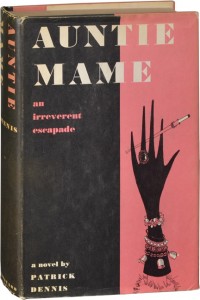
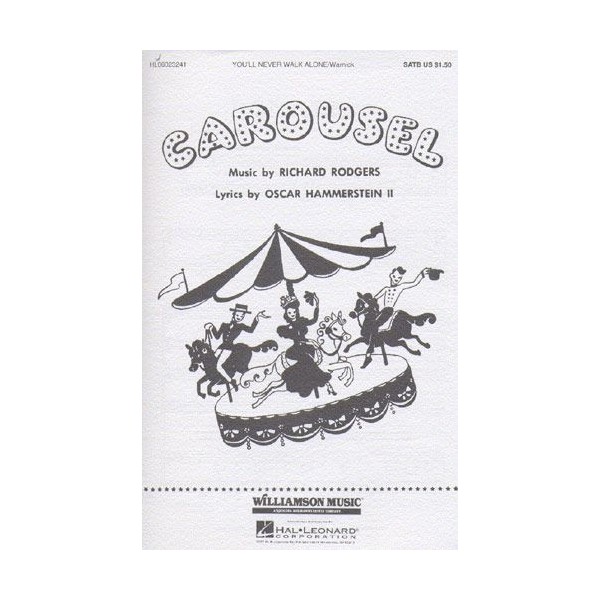
The Goodspeed’s Herman-izing again—Mame!
And they have just announced where and when—Mame!
It’s directed by Ray Roderick—he did My One and Only too
But it’ll be a while ‘til we know who’s playing Mame, who who who who?
With a couple of weeks to go in their current season, Goodspeed Musicals is whetting appetites for 2012 with the announcement of two of the three shows happening at their main digs, the Goodspeed Opera House. The April-December, 2012 season will be the theater’s 49th.
Mame opens the season April 20-July 1, directed by Ray Roderick (who did two Goodspeed shows this season, My Own and Only and Hello! My Baby, the latter still up and running through Nov. 27 at the Norma Terris Theatre in Chester). The advance notice gives you a chance to reread the original Patrick Dennis novel Auntie Mame: An Irreverent Escapade, on which the musical is based.
The show’s 80-year-old composer/lyricist Jerry Herman will reportedly consult on the production. Mame’s book is by the prolific playwriting partners Jerome Lawrence and Robert E. Lee, who revised their own straight-play adaptation of Dennis’ quasi-autobiographical into the musical.
The Goodspeed did an earlier Herman/Lawrence/Lee collaboration, Dear World (based on The Madwoman of Chaillot) at its Norma Terris Theatre eleven years ago. Herman’s Mack and Mabel (about silent movie icons Mack Sennett and Mabel Normand, with a book by Michael Stewart) played the Goodspeed Opera House in 2004, with Herman in attendance on opening night. The theater bestowed one of its Goodspeed Awards for Outstanding Contribution to Musical Theatre on Herman in 2007.
Following Mame’s run, June will be busting out all over—in mid-July, through Sept. 23—with a new production of Rodgers & Hammerstein’s Carousel. Yes, those who despair that Jerry Lewis is no longer singing “You’ll Never Walk Alone” at the close of the Labor Day telethon will get a chance to hear the song done in its original context.
If Carousel—with its grand dance sequences and, um, that carousel—seems a tad large for the intimate Goodspeed stage, rest assured that the Goodspeed’s entrusted it to director Rob Ruggiero. It was Ruggiero who so adroitly shoehorned the even grander Showboat onto the same Goodspeed Opera House stage this season. Wouldn’t it be funny if the staging required somebody in Carousel to walk alone?
Despite their larger-than-life Broadway pedigrees, Mame and Carousel both share affinities with the regional theater movement that the Goodspeed exemplifies. Jerome Lawrence and Robert E. Lee (whose biggest hit was the socially conscious legal drama Inherit the Wind) were pioneers of that movement via their non-commercially-motivated American Playwright’s Theatre. Carousel is based on Ference Molnar’s 1909 play Liliom, the two best-known American productions of which were both produced by another proudly non-commercial producing organization, the Theatre Guild. Carousel is now routinely scaled down for small theaters—especially, it seems, in Chicago. The Court Theatre’s 2008 production later played New Haven’s Long Wharf Theatre, and the Chicago Lyric Opera company did its own reconstituted Carousel just last year.
The choreographers for both Mame and Carousel’s choreographers are new to the Goodspeed, and both bear Broadway “Associate Choreographer” credits: Mame’s Vince Pesce for Anything Goes, Pajama Game, Wonderful Town and Little Shop of Horrors and Carousel’s Parker Esse for Finian’s Rainbow and A Tale of Two Cities.
The Goodspeed Opera House’s third and final show of the 2012 season, which will play Oct. 5-Dec. 9, has yet to be announced, as does the entire sched of new musicals at the Norma Terris space. It’s not too early to subscribe, however: three shows for $81-$216, depending on when you go and where you sit. Single tickets for the shows don’t go on sale until late February.
The Street Scenes Review
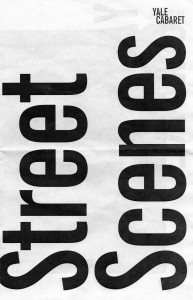
Street Scenes
Through Nov. 12 at the Yale Cabaret, 217 Park St., New Haven. Conceived by Maayan Strauss and Colin Mannex. Co-directors: Mannex, Strauss and Jessica Rizzo. Set Design: Edward T. Morris. Lighting Design: Benjamin Ehrenreich. Projection Design: Micah Stieglitz. Sound Composition: Palmer. Performers: Mannex, Strauss, Huei Li Leow, Matthew Maturi-Kioi, Tameka Norris, Eric Sirakian.
In the coming- attraction remarks at Yale Cabaret shows in recent weeks, when it was mentioned that the theater was adapting the emails sent to the Yale community by the university’s police department, there was invariably laughter. It was easy to imagine a snarky revue reenacting episodes from the crime log. Artful retellings of criminal doubles have become a staple of newspapers and web sites. Maybe this could like the rock musical Chad Raines fashioned out of Missed Connections postings on Craigslist for the Cabaret a couple of seasons ago.
Thankfully, Street Scenes is not that. Nor is it the other sort of community-conscious theater style the Cabaret has delved into occasionally over the years: slices of life where familiar faces from downtown (usually the homeless and itinerant) are impersonated.
Street Scenes is admirably abstract. Its creators have pored through the endless stream of safety and security advisories all students receive, then looked beyond them. They deconstruct the simple messages—typically that there has been a mugging near campus and thus the reader should be careful when going home at night.
The purposely disappointed play dramatizes debates about the reenact of speaking constant alleges about violence. It wonders what stereotypes are being created and affirmed by how the alerts ate worded. One of the many smart things that Street Scenes does in testing the effects of violent crime stories on an audiences is play openly with expectations. You start hearing a story and apply it to the person telling it, then realize that the character is a different gender, race or size than the actor. That’s a sort of theatrical violation and provocation that exactly fits the theme at hand.
Street Scenes demonstrates the “us versus them” mentality which develops between Yale and the outside world thanks to alley admissions such as “the victim was not a member of the Yale community, but…” it wonders why only three or four streets tend to get singled out on the notices.
I’ve lived in a house on one of those maligned streets for the past eleven years, and lived in a couple of different places on the street for four years a few decades ago. Watching Street Scenes was like learning that a friend of mine had a worse reputation than I’d realized, and that the gossip and innuendo was constantly undermining any attempt at rehabilitation. Defining neighborhoods by their potential for crime, street scenes intimated, is as insidious as defining people that way.
Which is why I was so drawn to the set design for this sparsely staged show, which communicates mainly through monologues and dance and alienation effects such as having the performers constantly plugged into mobile phones.
The set is a flat red surface with a street map of downtown new haven etched into it. The pattern shows New Haven from the waterfront on one end to Career High School on the other. The performers philosophize, fear and fret upon it, wearing themselves and the city down with worry.
I didn’t stay for the talkback—Cabaret shows rarely come with talkbacks, but each performance of Street Scenes has one—because part of me felt this wasn’t my dialogue, and also because I felt completely sated by what I’d already seen.
City Folk in East Haddam: Chats with Burke Moses and Liz Pearce from the Goodspeed Opera House production of City of Angels
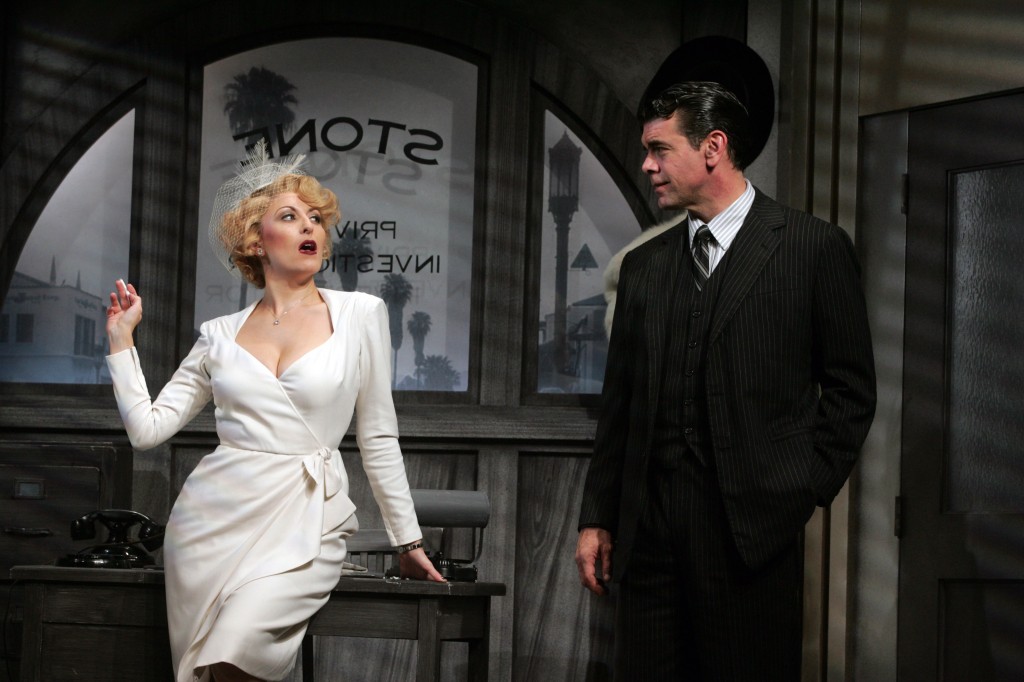
Liz Pearce and Burke Moses get noir in City of Angels, through Nov. 27 at the Goodspeed Opera House. Photo by Diane Sobolewski.
To my deepest noir chagrin, I have not yet seen City of Angels at Goodspeed Opera House. Oh, I assuredly will—it’s up through nearly the end of November, and this rousing hardboiled musical is so rarely revived that this production is an unmissable opportunity. I have wonderful memories of the original Broadway production (which won half a dozen Tonys and boosted the career of James Naughton) in the early ’90s and the subsequent national tour which co-starred The Brady Bunch’s Barry Williams.
The relative lack of productions the show’s had since its initial success, even on the regional, college and small-theater level, is a mystery as large as the dreamy one at the center of Larry Gelbart & Cy Coleman’s show. According to Larry Gelbart’s misshapen and rambling 1998 memoir Laughing Matters, the development of the show could not have not gone more smoothly, from Cy Coleman’s initial pitch to work on a “true jazz” musical about “private eye movies of the ‘40s” to director Michael Blakemore’s insistence that the show’s title be changed from Death is for Suckers to something less overtly parodic and more fitting for a “perfectly executed, respectful version of a ‘40s film noir.”
A few weeks back I had a chance to discuss the Goodspeed’s fresh production of City of Angels with two of its stars, Burke Moses and Liz Pearce.
Moses, who plays the fictional ‘40s gumshoe Stone—a figment of the imagination of modern-day screenwriter Stine (played by D.B. Bond) in the show—agrees that exaggerated comedy is not appropriate here. For starters, he says, “I never do camp.” But beyond that, “this text is so subtle. The only way to do this kind of parody is to play it close to the bone. It’s an unbelievably clever script, not your standard musical jokes. Some of the lines, you have to wait two or three beats for them to connect. To prepare, I watched a lot of film noir, and realized that there’s far more to Humphrey Bogart than I thought.”
Burke Moses has made his career in musical theater—including at Goodspeed, where he stood out on the crowded stage of Seven Brides for Seven Brothers—but “when I was a young guy, with this baritone voice, I couldn’t get heard for a musical. Then, when I was in my early 30s, I got two calls in the same week: one to replace the Sky Masterston in Guys and Dolls, the other for a new musical being developed then, Beauty and the Beast.” He found his calling in manly roles like Stone. In fact, he’s one of the few actors in this City of Angels who’s had an opportunity to do the seldom-revived show previously—in a West Coast concert version features rewrites and other revisions by creators Gelbart and Coleman themselves.
He loves returning to Goodspeed because it promises “quite a lengthy rehearsal process. You don’t come here for the pay, but because they consistently do quality work.
“The book is complex, because you have the color story and the black and white story. My character personally doesn’t change, but some of the other actors have to be two completely different characters. Darko [Tresnjak], I hadn’t met him before this, and he’s done a hell of a job. He understands pacing. This production is very clear. We’re able to do things technically, with a lot of projections, and that helps. Plus Cy Coleman set out to write a real jazz score, with swing and bebop.
“It’s why I love musical theater—it’s the only medium that can actually give an audience goosebumps.”

Stine (D.B. Bond, foreground) and Stone (Burke Moses, behind center) are nothing without each other in City of Angels. Diane Sobolewski photo.
Liz Pearce, who plays the dual role of femme fatale Alaura Kingsley and film celebrity Carla Haywood, worked with Burke Moses previously at Goodspeed in that stage-filling Seven Brides for Seven Brothers, but she’s better known for a more recent testosterone-terpsichorean musical, Billy Elliott. She returns to the Broadway cast of that show for the final months of the New York run once the Goodspeed gig ends this month.
Theatergoers with children may recongnize Pearce from tours of the high-quality stage adaptation of the Scooby-Doo cartoons. Pearce met her husband Piere-Marc Diennet while doing Scooby-Doo in Stagefright. She finds City of Angels, despite its colorful manner and purposeful use of cinematic clichés, to be a much less cartoonish mystery machine. “I play Alaura in the film noir sequences, this seductive, sexy, conniving woman. But I’m also Carla Haywood, the movie star who plays Alaura, and she’s honest and straightforward.” Pearce found the humanity in both roles. “I have a lot of dialogue, only one short song, and no dancing, so for me it’s more like a play. The style of film noir acting is very difficult. I studied Double Indemnity before I even auditioned.
“The jazz really adds to the feeling of the show. You can tell the orchestra adores playing it. There are these incredible costumes and wigs. Burke and I have a great time. We come off stage and just start laughing.
“Working with Darko was also a big incentive for me,” Pearce continues. So did returning to the Goodspeed, where she began her career with a central role in the theater’s production of George M! a decade ago. “After three years in the city, it’s great to escape out here. Everybody feels like family.”
Cullom of Queens
NHTJ reader Ted Brooks sent this in: a page three article in Crain’s New York, the business paper, about Ray Cullom and his revitalization of the Queens Theatre in Queens, New York. Not where I usually think to look for theater news, but this is a multi-million dollar business transformation story.
Cullom, you might recall, was the Managing Director of the Long Wharf Theatre for a couple of years before accepting an Executive Director gig at the rapidly expanding, newly renovated space formerly known as Queens Theatre in the Park. Under Cullom, the theater has already hosted the pre-Broadway try-out of the musical Chix 6, is adding a cabaret room, and is booking over 200 nights this season, three times what the place had been doing previously.
Cullom was the guy who had to fire a whole bunch of people at Long Wharf in order to balance the budget and survive the national economic downturn. He’s had to swing an axe at Queens as well, but–as he was with the Long Wharf—he’s not just about stability but longterm growth. Sucks that Long Wharf couldn’t hold onto him a bit longer.
Long Wharf, by the way, has yet to officially replace Cullom. The interim Managing Director since he left has been the able Yale School of Drama grad Joshua Borenstein, who served Long Wharf earlier as Associate Managing Director.
Long Wharf will soon announce its own renovation plans, the follow-up to its wise decision to not move its whole enterprise downtown just yet and renew its lease in the Sargent Drive meatpacking docks for another decade.
Outrageous Acorn
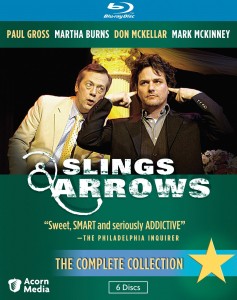
I’ve hipped you to Acorn TV before. It’s the online mini-network broadcasting famous British series such as Upstairs Downstairs, Midsomer Murders and others distributed on DVD by Acorn Media, for $25 a year. They put up one complete season of each of several series on the Acorn TV site at a time, then rotate them out every six weeks or so.
This Monday, Nov. 14, the first season of Slings & Arrows joins the roster. The show, about the hauntings and happenings at a Canadian summer Shakespeare festival theater, was created by and co-stars Mark McKinney. He’s the Kids in the Hall member who did the most live stage work following that show’s demise, including playing Millet in the New York production of David Lindsay-Abaire’s Fuddy Meers and co-writing the internationally touring Scooby-Doo Live.
Slings & Arrows is the greatest TV dramedy about running a Shakespeare theater since… Well, even if somebody else had ever done something remotely similar, Slings & Arrows would be better. It gets the pretensions and preoccupations dead right, but also shows theater as something worth doing and fighting for.
All together now:
Call the understudy
I can’t go on tonight
I’m drinking with my buddy
I’m getting good and tight
Before they raise the curtain I’ll be higher than a kite
So call the understudy
I can’t go on tonight
Tell the cast and crew to break a leg
Roll me out another bloody keg
I need to ease the pain that life can bring
And liquor is what will hit the spot
The play is not the thing
So call the understudy
I think it’s only right
My diction will be muddy
I’ll never find my light
Before the intermission I’ll be pissing on a sprite
So call the understudy
I can’t go on (“He can’t go on!”)
I won’t go on (“He shan’t go on!”)
I can’t go on tonight (“Damn right!”)
Yesterday’s Play in a Day
So we did Gozzi’s Love of Three Oranges, with a cast of nine children. The king role absorbed the Truffaldino and Pantalone roles as well, and Smeraldina handled some of the Truffaldino exposition and got a pie in the face (as did Fata Morgana).
I’ve posted the entire 12-minute epic on the NHTJ Play in a Day page, here. Here’s an alternate take of the opening prologue. The squabbling over which type of play to do comes straight from Gozzi’s scenario, by the way.
Play in a Day for November TODAY (Tuesday the 8th)
Doing another of my quirky Play in a Day kids’ theater projects today, Tuesday Nov. 8, at Never Ending Books (810 State St., New Haven). Videos of previous projects are on NHTJ’s dedicated Play in a Day page, here.
Often I don’t know for sure which classic script from world theater we’ll be adapting, until the potential cast shows up. But today I’ve at least allowed myself to pick the style beforehand: commedia dell’arte. It’s buffoonish fun using masks and comic archetypes such as the sly servant and the clueless master.
We’re adding a second session onto the Play in a Day day today, for mask- and set-building, from 11 a.m. to 2 p.m. Then we’ll do the accustomed 2-5 p.m. stint in which we plan, rehearse and perform the play. Parents can come get their kids at 5 p.m. and see the results performed.
This will be a special longer session, with mask-making and set-building from 11 a.m. until 2 p.m., then the usual three-hour period in which we devise and rehearse the play, which will be performed at 5 p.m. There’ll be lunch in there somewhere too. Kids can come for the whole 11-5 period (Fee: $10) or just for the 2-5 afternoon session (Fee: $5).
Play in a Day is a children’s theater project in which a classic theater script is adapted, designed, rehearsed and performed—by children, under the direction of the sole alleged grown-up, Christopher Arnott—in a single three-hour session. Parents drop off their kids at Neverending Books at 810 State Street, then return three hours later to see a show and maybe stick around for pizza and chat.
Contact Christopher Arnott at chris@scribblers.us for details.
